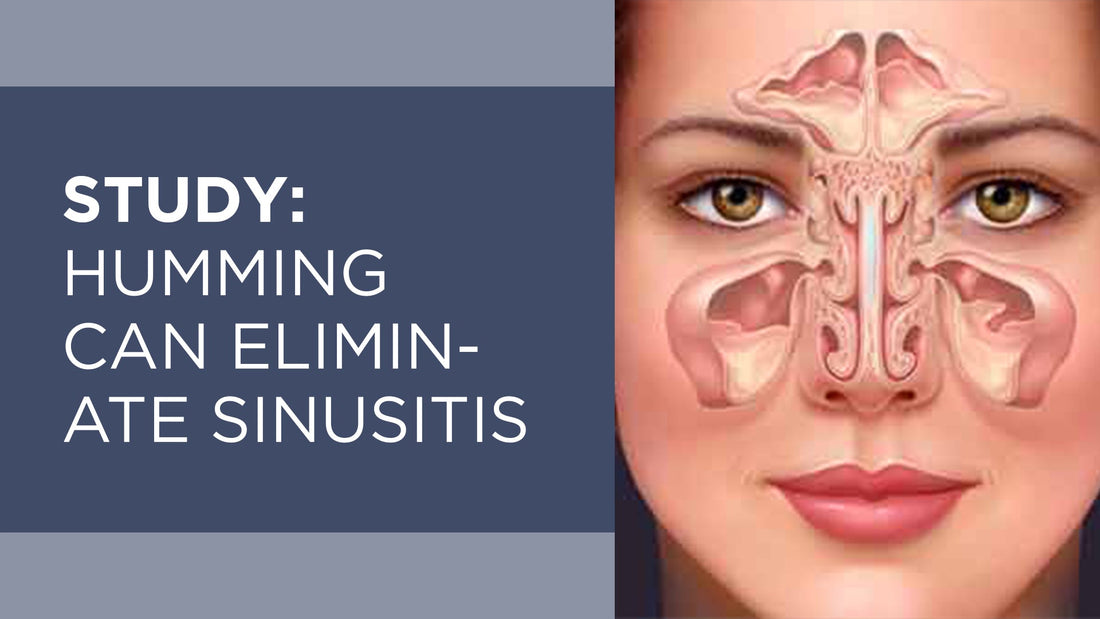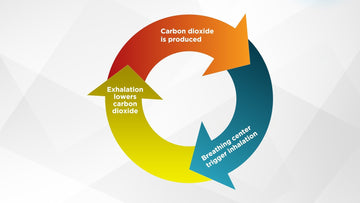
Humming can eliminate sinusitis
Studies done at the Karolinska Institute in Sweden shows that a humming sound leads to a dramatic increase of the airflow in the sinuses. Further the levels of nitric oxide (NO) increases 15- to 20-fold by humming compared with quiet exhalation. NO is known to be broadly antifungal, antiviral and antibacterial. Impaired breathing leads to poor air circulation and lower pressure in the nose and sinuses, thus creating an environment beneficial for bacterial growth and inflammations.
Humming could then have a positive effect on sinusitis. By humming 60—120 times four times per day, chronic sinusitis symptoms were essentially eliminated in 4 days. Read more on how to unblock a stuffy nose.
Exercise — Humming
- Close your mouth and let the front part of the tongue rest in its natural place in the roof of the mouth, behind the front teeth.
- On exhalation, say "Hmmm…", in other words, push together your vocal cords and squeeze the air out through the nose so that a humming sound occurs.
- You can feel the vibrations slightly in your jaw. The vibrations increase the air circulation and the production of NO in the nose and sinuses.
- In a chronically blocked nose or sinusitis, repeat for 20-40 breaths (approx. 5-10 minutes) 2-4 times a day for a few days or until the problems are resolved.
To increase the effect you can, while humming, massage the area around your nose, temples and above your eyes (since we have sinuses there as well). If you have a sore throat, you can massage your throat and the root of your tongue. The massage stimulates the blood circulation in these areas. The throat massage also stimulates the vagus nerve which is directly coupled to our rest and digest system (the parasympathetic part of the autonomic nervous system).
The exercise could also be done preventively, for example when you are about to get a cold, or just being in the mood to do it.
Scientific references
Title: Humming, Nitric Oxide and Paranasal Sinus Ventilation
Authors: Maniscalco, M.
Journal: Karolinska Institutet (Sweden), 2006.
Link to full text: Humming, Nitric Oxide and Paranasal Sinus Ventilation ![]()
Abstract: The paranasal sinuses are air-filled bony cavities surrounding the nose. They communicate with the nose via the sinus ostia through which fluid and gases pass in both directions. A proper ventilation is crucial for sinus integrity and blockage of the ostia is a major risk factor for development of sinusitis. In this thesis we have explored an entirely new approach to monitor sinus ventilation- the nasal humming test. We show in human studies in vivo and in a sinus/nasal model that the oscillating airflow generated during humming produce a dramatic increase in sinus ventilation. Interestingly, this increased gas exchange can be readily monitored on-line by simultaneously measuring the levels of the gas nitric oxide (NO) in nasally exhaled air. The sinuses constitute a major natural reservoir of NO and when gas-exchange increases during humming NO escapes rapidly into the nasal cavity thereby creating a highly reproducible peak in exhaled NO. When exploring the different factors that determine the humming peak in NO we found that sinus ostium size was the most important but the humming frequency also influenced the sinus NO release. In patients with severe nasal polyposis and completely blocked sinus ostia the humming peak in NO was abolished. Moreover, in patients with allergic rhinitis, absence of a NO peak was associated with endoscopic signs suggestive of ostial obstruction. In the last study we went on to study if an oscillating airflow could be used not only to wash a gas out from the sinuses but also to enhance passage of substances into the sinuses. Indeed, we found evidence of an increased intra-sinus drug deposition by adding a sounding airflow to an aerosol. In conclusion, the ventilation of the paranasal sinuses increases greatly when a person is humming; a finding that could have both diagnostic and therapeutic implications. Measurements of nasal NO during humming may represent a test of sinus ostialfunction. In addition, aerosol in combination with a sounding airflow could possibly be useful to increase the delivery of drugs into the paranasal sinuses.
Title: Exhaled nasal nitric oxide during humming: potential clinical tool in sinonasal disease?
Authors: Maniscalco M, Pelaia G, Sofia M.
Journal: Biomark Med. 2013 Apr;7(2):261-6. doi: 10.2217/bmm.13.11. PMID: 23547821.
Link to PubMed: Exhaled nasal nitric oxide during humming: potential clinical tool in sinonasal disease? ![]()
Abstract: The use of nasal nitric oxide (nNO) in sinonasal disease has recently been advocated as a potential tool to explore upper inflammatory airway disease. However, it is currently hampered by some factors including the wide range of measurement methods, the presence of various confounding factors and the heterogeneity of the study population. The contribution of nasal airway and paranasal sinuses communicating with the nose through the ostia represents the main confounding factor. There is accumulating evidence that nasal humming (which is the production of a tone without opening the lips or forming words) during nNO measurement increases nNO levels due to a rapid gas exchange in the paranasal sinuses. The aim of this review is to discuss the basic concepts and clinical applications of nNO assessment during humming, which represents a simple and noninvasive method to approach sinonasal disease.
Title: Strong humming for one hour daily to terminate chronic rhinosinusitis in four days: a case report and hypothesis for action by stimulation of endogenous nasal nitric oxide production
Authors: Eby GA.
Journal: Med Hypotheses. 2006;66(4):851-4. doi: 10.1016/j.mehy.2005.11.035. Epub 2006 Jan 10. PMID: 16406689.
Abstract: Rhinosinusitis is an inflammation or infection of the nose and air pockets (sinuses) above, below and between the eyes which connect with the back of the nose through tiny openings (ostia). Rhinosinusitis can be caused by bacteria, viruses, fungi (molds) and possibly by allergies. Chronic rhinosinusitis (CRS) is an immune disorder caused by fungi. The immune response produced by eosinophils causes the fungi to be attacked, which leads to damage of the sinus membranes, resulting in full-blown rhinosinusitis symptoms. Gaseous nitric oxide (NO) is naturally released in the human respiratory tract. The major part of NO found in exhaled air originates in the nasal airways, although significant production of NO also takes place in the paranasal sinuses. Proper ventilation is essential for maintenance of sinus integrity, and blockage of the ostium is a central event in pathogenesis of sinusitis. Concentrations of NO in the healthy sinuses are high. Nasal NO is known to be increased 15- to 20-fold by humming compared with quiet exhalation. NO is known to be broadly antifungal, antiviral and antibacterial. This case report shows that a subject hummed strongly at a low pitch ( approximately 130 Hz) for 1h (18 hums per minute) at bedtime the first night, and hummed 60-120 times 4 times a day for the following 4 days as treatment for severe CRS. The humming technique was described as being one that maximally increased intranasal vibrations, but less than that required to produce dizziness. The morning after the first 1-h humming session, the subject awoke with a clear nose and found himself breathing easily through his nose for the first time in over 1 month. During the following 4 days, CRS symptoms slightly reoccurred, but with much less intensity each day. By humming 60-120 times four times per day (with a session at bedtime), CRS symptoms were essentially eliminated in 4 days. Coincidentally, the subject's cardiac arrhythmias (PACs) were greatly lessened. It is hypothesized that strong, prolonged humming increased endogenous nasal NO production, thus eliminating CRS by antifungal means.







